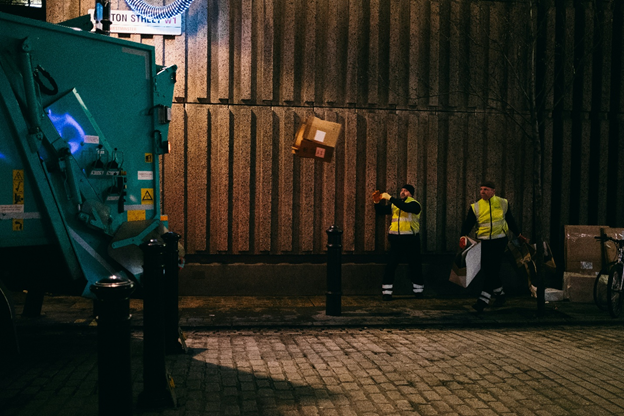Being able to have a dumpster on a small job site is part of the routine. And it can stay routine if you handle the dumpster properly. One poor drop, an unbalanced load, or a missed pick-up can alter your schedule, or worse, injure your crew.
The good news is that most issues you will experience will be avoidable once you know where the accidents happen and how to prevent them. Use these guidelines to keep people, property, and cash intact, from the moment the box comes off the truck to the day it leaves full.
Can a Dumpster Damage My Driveway?
Even a medium-sized roll-off dumpster can weigh several tons once it has been filled with construction debris, and that weight wants to settle in to where it will. If you place the dumpster directly on asphalt or concrete, it will likely crack, gouge, or rust stain in a way that the homeowner will see long after you have gone away.
To avoid expensive repairs, especially on a client’s property, lay down some durable boards or sheets of ¾-inch plywood before the truck lowers the dumpster. A seasoned Spokane dumpster rental driver will probably have skids for this purpose, but having your own material on site is a small way to ensure you are covered. You should keep the surface level, and check that the dumpster stays more or less centered throughout the job, so that the corners don’t settle too far.
OSHA Loading Rules You Need
The Occupational Safety and Health Administration treats dumpsters like any other heavy equipment: misuse can lead to fines or injuries. Before you toss the first scrap, know the rules.
OSHA articulates what is required, but it is also good to see a snapshot of the facts:
- Don’t ever climb into a container. Use a ladder only if the box is locked out and is then empty.
- Distribute the weight of the load evenly from front to back—don’t create a top-heavy mound where the load could shift in transit.
- Keep materials below the rim. When you’re ready for pickup, cover your load with a tarp to reduce the likelihood of debris blowing off the truck while on the road.
- Post easily recognizable signage to indicate what does not belong in the box—paint and solvents and hot asphalt belong in specialty drums, not your dumpster.
- Establish an effective safe approach zone: no personnel should be standing in swinging door range when the door is opened. See https://ohsonline.com/articles/2025/07/09/dumpster-safety-tips-every-construction-crew-should-follow.aspx for more details.
Treat these steps as non-negotiable parts of your waste management solution. They protect workers and help you avoid OSHA penalties that can cripple a small operation.
Keeping Kids and Pets Safe
Residential remodels often unfold in the middle of family life, so you need a plan for curious onlookers. Position the container away from play areas and fence lines. If space is tight, schedule heavy hauls during school hours and keep the access gate locked after hours.
A roll-off container can look like a jungle gym to a ten-year-old, but hidden nails and shifting materials make it anything but. Post simple “No Entry” signs in both English and Spanish if your crew is bilingual, and do a quick perimeter check each evening before you pull out.
Wearing Proper PPE
If you gear up for saws and nail guns, then you should gear up for loading a dumpster, as well. Closed-toe work boots, heavy gloves, and wrap-around style safety glasses protect your feet from sharp edges and your safety from debris dust. If the debris is being thrown over side walls that are more than chest-height, add a hardhat. Also, if the dumpster is near traffic lanes, or the evening work light is in play (cone the dumpster area off), wear a high-visibility vest.
Long sleeves will protect your skin from protruding fiberglass when working with insulation, and any screws hiding in drywall. For demo work with plaster, or any concrete, a half-mask respirator will filter the silica dust that masks cannot. These essentials don’t cost a lot of money, and they can prevent most of the dumpster-related injuries from being reported on construction sites. Remember, personal protective equipment is intended to increase your safety, not take the place of safe technique. For example, make PPE (see here for more info) inspections part of your morning huddle so everyone at least shows up covered each day.
When to Call for Pickup
Letting trash pile past the rim creates hazards you can’t ignore. A timely haul away service keeps projects humming and neighbors calm. Here’s when you should reach for the phone:
- You’re nearing the weight limit noted on the ticket, even if the box isn’t full.
- Lightweight debris is flush with the top rail—anything higher won’t tarp safely.
- Weather is turning wet or windy, increasing the chance that loose insulation or plastic will blow out.
- The next phase of work needs clear space around the box for equipment or deliveries.
- Your permit window is about to expire; overstaying can bring fines or tow fees from the city.
Pro tip: schedule swap-outs a day ahead so the dispatcher can line up trucks without bumping you for emergency calls. A little foresight also lets you choose an early time slot, reducing the chance that your crew waits around instead of framing walls. Understanding the typical rental period and booking extensions before you need them is cheaper than paying overflow or standby charges.
Loading a dumpster safely and gently on a property location is not just lucky circumstance, it is a list of ideas you put to practice each and every time. Plan the site, follow OSHA guidelines, protect the public, and outfit yourself, then pull the plug on the dumpster before it wears out its welcome.
If you apply best practices to every stage of the project, the dumpster should remain your quiet partner on each job, and not the lead story in the accident report of tomorrow. By taking these habits on-board, you will keep projects on track, permits in good standing, and clients that will be eager to recommend you and your crew!


